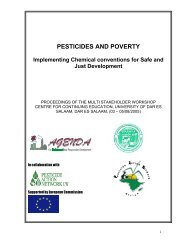Your Daily Poison - Pesticide Action Network UK
Your Daily Poison - Pesticide Action Network UK
Your Daily Poison - Pesticide Action Network UK
Create successful ePaper yourself
Turn your PDF publications into a flip-book with our unique Google optimized e-Paper software.
Table 3) who responded to the PAN <strong>UK</strong> survey<br />
had received reports of a total of 11 incidents,<br />
and in only three cases were they reported to<br />
the HSE. In 2004 six local authorities reported<br />
a total of 11 incidents, of which one was<br />
reported to the HSE. The return rate to our<br />
questionnaire was very poor; but if a half to a<br />
third of all 468 local authorities in the <strong>UK</strong> has<br />
such incidents reported to them, which never<br />
reach the HSE, this is a significant underreporting<br />
issue.<br />
e. THE PEX DATABASE<br />
PAN <strong>UK</strong>’s PEX - <strong>Action</strong> on <strong>Pesticide</strong> Exposure<br />
information service and database collects<br />
evidence of pesticide exposures and their<br />
effects on health. There are 973 entries on the<br />
database, which have accumulated since the<br />
project was initiated by Mrs Enfys Chapman as<br />
the <strong>Pesticide</strong> Exposure Group of Sufferers<br />
(PEGS) project, passed to PAN <strong>UK</strong> in 1998.<br />
We also receive around 1200 enquiries per<br />
annum on pesticide exposure issues generally.<br />
As well as providing an advice and support<br />
service, the PEX project analyses these<br />
exposures, raises issues with the regulatory<br />
authorities, and campaigns for a reduction in<br />
pesticide exposure.<br />
The routes of exposure reported to us are via<br />
inhalation and dermal exposure from spray-drift<br />
and vapour in the environment. The RCEP<br />
estimates, in the new report, that between 1<br />
and 1.5 million people live in homes bordering<br />
agricultural and horticultural land in Great<br />
Britain, so numbers reporting to PEX are a<br />
small percentage of potential exposure cases.<br />
Illnesses caused by the ingestion of pesticides<br />
in food and water are not reported, because it<br />
Table 3. Incidents and bystander exposure reported to<br />
local authorities. Summary of PAN <strong>UK</strong> survey –<br />
Appendix 4c, page 41.<br />
PAN <strong>UK</strong> Questionnaire sent Approx 468 local authorities in England, Wales,<br />
to: Scotland and Northern Ireland<br />
Number of responses In 2004 (2002 data) In 2005 (2004 data)<br />
received: 33 20<br />
Number of local authority In 2002 and 2003: In 2004:<br />
respondents reporting 11 6<br />
pesticide incidents<br />
Number of incidents 2002: 10; 2003 6; In 2004:<br />
others estimated, eg 11<br />
‘normally about six<br />
complaints per annum,<br />
of all kinds’<br />
6<br />
is impossible to link these to health effects<br />
without prompt laboratory and biochemical<br />
tests, which are prohibitively expensive and<br />
impractical in almost all circumstances.<br />
In 2004, we were contacted by 16 cases of<br />
new, current exposures, 12 of which were in<br />
the ‘bystander’ situation of living close to<br />
sprayed fields, and therefore having ongoing,<br />
repeated chronic exposures. We are aware<br />
that, in terms of numbers, only the tip of the<br />
iceberg is reported to PEX: many people<br />
exposed to pesticides do not know how to<br />
contact the right officials, or organisations such<br />
as ours. A selection of cases of people who<br />
contacted PAN <strong>UK</strong> in 2004-05 are described<br />
below.<br />
<strong>Pesticide</strong> exposure as a possible cause of<br />
chronic disease<br />
‘I have lived in this Hampshire village, of about<br />
500 residents, for nearly thirty years. In the last<br />
ten to twelve years, I have noticed a dramatic<br />
increase in the incidence of cancer. I can think<br />
of 26 people in the village who have either<br />
been diagnosed with cancer, or who have died<br />
from it recently. Two people who died<br />
developed three primary cancers, one after<br />
another. There are numerous cases of breast<br />
cancer, but also bone cancer. I am concerned<br />
that environmental factors may be causing<br />
some of these cancers. We live adjacent to a<br />
farm of a thousand acres and crops are<br />
regularly sprayed.’<br />
This report is consistent with a case in<br />
Gloucestershire reported previously to PEX, in<br />
which five people suffering from depression,<br />
leukaemia or cancer lived in the same row of<br />
houses backing onto sprayed fields. There are<br />
18 examples on our database in which<br />
‘clusters’ of disease have been reported to us,<br />
with the suspicion that pesticide exposure may<br />
be a contributory factor.<br />
Residential exposure<br />
‘I have lived in the country all my life. The<br />
farmer grows barley nearby and when they<br />
spray it fills the house. In the spring I put all my<br />
washing on the line which was then<br />
oversprayed. If they notified me this kind of<br />
thing could be avoided. I get irritable bowel<br />
syndrome when they are spraying and I am<br />
concerned for my children and being out in our<br />
garden with them. The smell from the spray<br />
can be really bad. Our garden is approximately<br />
twenty metres from field edge.’<br />
<strong>Your</strong> daily poison

















